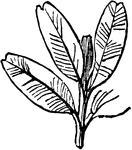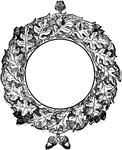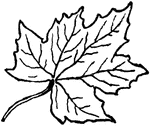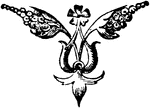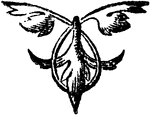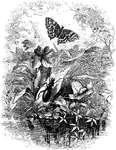
Leaf Enrichment Moulding
The leaf enrichment moulding is a bent row of leaves, growing upwards and then bent outwards.

Colossal Egg-and-Leaf Moulding
The colossal egg-and-leaf moulding is found in the temple of Jupiter Tonans, Rome.

Roman Egg-and-Dart Moulding
The Roman egg-and-dart moulding is an egg pattern with darts in between.

Renaissance Egg-and-Dart Moulding
The Renaissance egg-and-dart moulding is an egg pattern with darts in between.

Leaf Enrichment Moulding
The leaf enrichment moulding is a bent row of leaves, growing upwards and then bent outwards.

Leaf Enrichment Moulding
The leaf enrichment moulding is a design found in Erechtheum, Athens an ancient Greek Temple.

Campana Egg-and-Tongue Moulding
The campana egg-and-tongue moulding is an egg pattern that is a Graeco-Italic design.
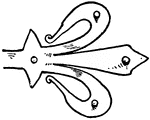
Plain Termination of Hinge
This plain termination of hinge is a 16th century design. It terminates as a leaf.

Plain Termination of Hinge
This plain termination of hinge is a 16th century design. It terminates as a leaf.
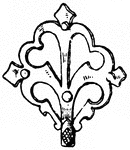
Termination of Hinge
This termination of hinge is found in a town-hall in Munster, Germany. It terminates as a leaf.
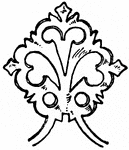
Termination of Hinge
This termination of hinge is found in a town-hall in Munster, Germany. It terminates as a leaf.
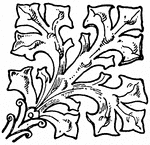
Termination of Hinge
This termination of hinge is found in Gelnhausen, Germany. It is a 15th century design that terminates…

Gothic Hinge
This gothic hinge comes from a door of a cabinet in a town-hall in Zwolle, Netherlands. It is a strap-hinge…

Greek-Corinthian Pilaster Capital
The Greek-Corinthian pilaster capital has a palmette leaf design with spiral scroll like ornaments on…

Roman-Corinthian Pilaster Capital
The Roman-Corinthian pilaster capital has a leaf and floral design, then it volutes with a spiral scroll…
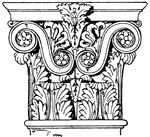
Roman-Corinthian Pilaster Capital
The Roman-Corinthian pilaster capital has a leaf and floral design, then it volutes with a spiral scroll…
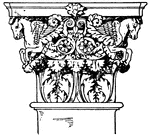
Roman-Corinthian Pilaster Capital
The Roman-Corinthian pilaster capital has a leaf and floral design, then it volutes with a spiral scroll…
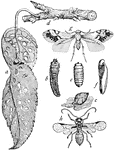
Resplendent Shield Bearer
"Resplendent Shield-bearer (Coptodisca splendoriferella). a, leaf of apple showing work; b, summer larva;…
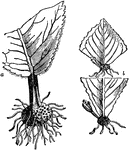
Leaf Cuttings
Plant propagation is the process of artificially or naturally distributing plants. Pictured here is…
Disk-floret of the Senecio
An illustration of a disk-floret of the senecio flower. Senecio is a genus of the daisy family (Asteraceae)…

Disk-floret of the Senecio (Longitudinal Section)
An longitudinal section view of a disk-floret of the senecio flower. Senecio is a genus of the daisy…

Female ray-floret of the Senecio
An illustration of a ray-floret of the senecio flower. Senecio is a genus of the daisy family (Asteraceae)…
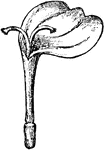
Gynaeceum of the Senecio
An illustration of the gynaeceum of the senecio flower. Senecio is a genus of the daisy family (Asteraceae)…
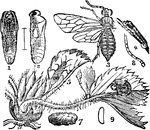
Strawberry Sawfly
"Strawberry False-worm (Emphytus maculatus). 1, 2 pupa, ventral and lateral views (line shows natural…

Plantain Flower and Bract
An illustration of a plantain plant flower and bract. In botany, a bract is a modified or specialized…
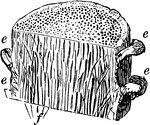
Palm Stem
Section of the stem from a palm tree, showing how endogens grow threw elongation internally. "1. Section…
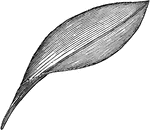
Endogenous Leaf
The image shows how endogens grow threw elongation internally. "Endogenous leaf, showing its parallel…

Epiphyllospermous Frond
"Part of Epiphyllospermous Frond. In botany, bearing the fruit or spores on the back of the leaves or…
Adderstongue
Lphioglossum (adder's-tongue) is a genus of about 25-30 species of Ophioglossales in the family Ophioglossaceae,…

Flower of a Moss
An illustration of the flower of a moss: ar, archegonium; an, antheridium; p, paraphysis; bl, leaf.

Coca Leaf
The leaf of the coca plant (Erythroxylon coca) best known for its use in the drug cocaine.

Duckweed
Common duckweed, Lemna. The entire plant is reduced to a leaf-like expansion which bears a…

Arrowhead
A leaf of arrowhead (Sagittaria), a member of the water-plantain family, growing abundantly…

Section of Branch Showing Exogen
"Exogen. 1. Section of a branch of three years' growth: a, medulla or pith; b b, medullary sheath; e…

Fascicle of Mallow Flowers
The image shows a fascicle (bundle or cluster) of flowers of a mallow plant (Malvaceae).

Fiddle-Shaped Leaf
A leaf which has "the form of a fiddle or violin; pandurate or panduriform: applied in botany to an…
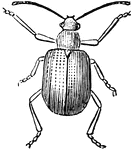
Grape Rootworm Beetle
The Grape Rootworm Beetle (Fidia viticida) is an insect in the Chrysomelidae family of leaf beetles.
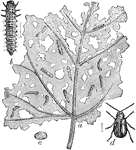
Grapevine Flea Beetle
The Grapevine Flea Beetle (Altica chalybea). "a, leaf infested with larvae; b, larva; c, cocoon; d,…

Fly Book for Fishing
"A case in the form of a book in which to keep fishing-flies. It has leaves of Bristol-board or other…

Tracery Foliations
The tracery on the windows of La Sainte-Chapelle, in Paris, France shows foliations: a leaf pattern…

Scab Fungus
"The Scab-fungus (Venturia inaequalis). a, an infested apple, showing scabs caused by the fungus; b,…
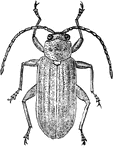
Dorsal View of Leaf Beetle
Galeruca notata is a beetle species in the Chrysomelidae family of leaf beetles.
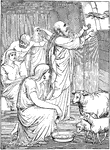
Return of the Dove to the Ark
"And the dove came in to him in the evening; and, lo, in her mouth was an olive leaf pluckt off: so…




